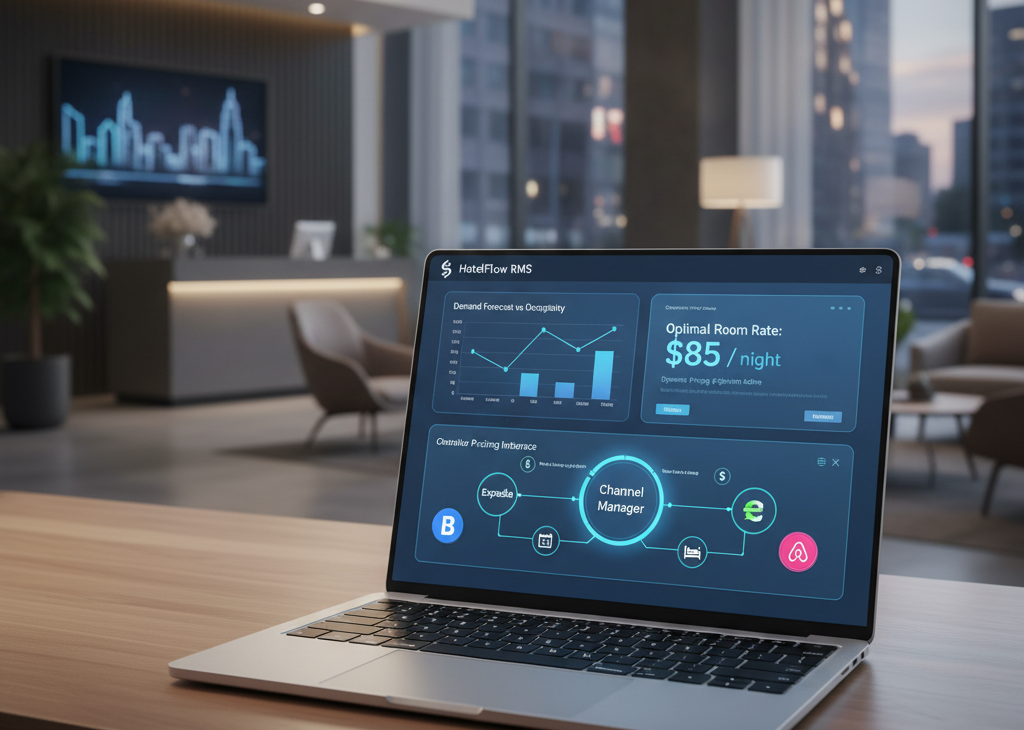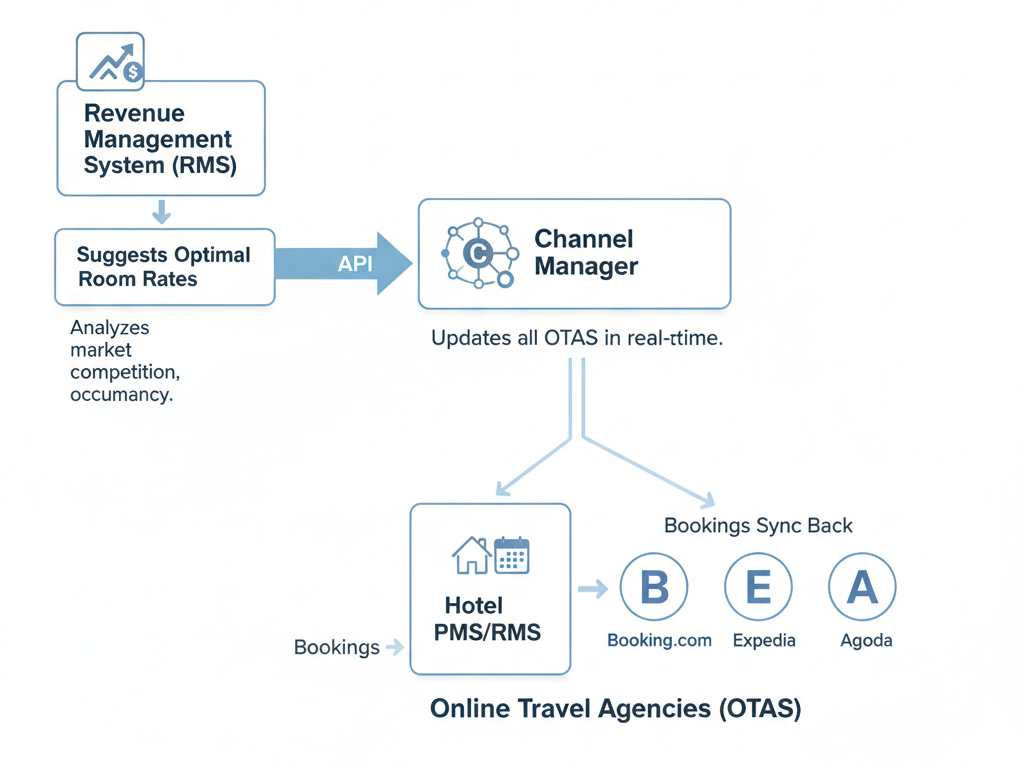Introduction
The hospitality industry has witnessed a remarkable evolution in technology over the past decade. Modern hotels no longer rely solely on manual processes; instead, they leverage cutting-edge hotel technology solutions to streamline operations, enhance guest experiences, and maximize revenue. From check-ins to inventory management, automation plays a pivotal role in improving efficiency across every department.
Thanks for reading this blog!, Looking for professional help with your hotel listings?
👉 [Sign up with SaasAro] or call 75000-87037 today!
If you’d prefer to handle the listing yourself, keep reading and enjoy the complete blog below.

Central to this transformation are SaaS hotel management tools and hospitality automation software, which allow hotels to integrate multiple operational functions into a single, seamless platform. Among these, Revenue Management Systems (RMS) and Channel Managers stand out as key tools. An RMS helps hotels make data-driven pricing and inventory decisions, while a Channel Manager ensures that room availability and rates are synchronized across all online travel agencies (OTAs) and booking platforms.
Understanding how Revenue Management Systems and Channel Managers work together is essential for hotels aiming to optimize revenue, reduce overbookings, and maintain consistent pricing strategies. By combining dynamic pricing intelligence with real-time distribution management, hotels can achieve higher occupancy rates and maximize profitability in today’s competitive market.
Understanding Revenue Management Systems (RMS)
A Revenue Management System (RMS) is a crucial tool in modern hotel management, designed to help properties maximize revenue and optimize occupancy. By analyzing historical data, market trends, and booking patterns, an RMS enables hotels to make informed pricing and inventory decisions that directly impact profitability.
Core Functions of an RMS:
-
Demand forecasting: Predicts occupancy levels and identifies peak booking periods.
-
Dynamic pricing: Automatically adjusts room rates in real-time based on market demand, competitor pricing, and seasonal trends.
-
Rate recommendations: Suggests optimal pricing for each room type to balance revenue and occupancy effectively.
Modern Hotel RMS software goes beyond these core functions by integrating seamlessly with other hotel systems like property management systems (PMS) and online booking channels. This Revenue Management System integration ensures that pricing strategies are executed automatically across all platforms, minimizing errors and manual effort.
Example – Cloud-Based RMS:
-
Centralized access to real-time data and actionable insights.
-
Automated rate adjustments in response to market fluctuations.
-
Consistent hotel revenue optimization while improving operational efficiency.
By combining advanced analytics with automated execution, an RMS empowers hotels to make smarter decisions, stay competitive, and enhance overall profitability.
What Is a Channel Manager and Why It Matters
A Channel Manager for hotels is a powerful tool that simplifies the distribution of room inventory across multiple sales channels, including online travel agencies (OTAs) like Goibibo , Expedia, and Agoda. By connecting a hotel’s property management system (PMS) with these platforms, a channel manager ensures that room availability, pricing, and bookings are updated in real-time across all listings.
Key Functions of a Channel Manager:
-
OTA Connectivity: Links your property to multiple OTAs, ensuring accurate OTA listings and consistent presence across platforms.
-
Inventory Distribution: Manages room inventory efficiently, preventing overbookings and ensuring availability across all channels.
-
Rate Management: Supports OTA rate management by synchronizing pricing updates instantly, helping hotels maintain competitive rates.
-
Booking Consistency: Automatically updates reservations and cancellations to avoid errors, double bookings, or discrepancies.
With the right channel manager, hotels can save significant time, reduce manual workload, and improve operational efficiency. It not only ensures smooth OTA listing management but also plays a crucial role in maximizing bookings and revenue by maintaining consistent rates across all platforms.
The Need for Integration Between RMS and Channel Manager
Hotels today face a fast-paced, competitive market where even minor pricing errors can lead to lost revenue or overbookings. Without proper system integration, many properties struggle with:
-
Manual rate updates: Updating room prices across multiple OTAs is time-consuming and prone to errors.
-
Overbooking or rate discrepancies: Lack of synchronization can result in double bookings or inconsistent rates across channels.
-
Delayed response to market changes: Hotels cannot react quickly to demand fluctuations or competitor pricing without automated tools.
Integrating a Revenue Management System (RMS) with a Channel Manager solves these challenges by enabling seamless communication between systems.
Key Benefits of RMS and Channel Manager Integration:
| Key Benefit | Description |
|---|---|
| Real-time pricing updates | Rates and availability are synchronized instantly across all channels, preventing discrepancies and maximizing revenue. |
| Centralized control of pricing strategies | Hotels can manage pricing decisions from a single dashboard, reducing manual effort and errors. |
| Accurate data flow and automation | Automated integration ensures reliable data for forecasting, reporting, and revenue optimization, helping hotels make smarter business decisions. |
| Competitive advantage | By combining an RMS with a Channel Manager, hotels gain efficiency, accuracy, and proactive Revenue Management System integration. This ensures smooth operations, improved guest satisfaction, and maximized profitability. |
How Revenue Management Systems and Channel Managers Work Together
The synergy between a Revenue Management System (RMS) and a Channel Manager is essential for modern hotel operations. When integrated, these tools streamline pricing, distribution, and booking management, ensuring hotels stay competitive and maximize revenue.
Step-by-Step Workflow:
-
Data Collection:
-
The RMS analyzes market demand, competitor pricing, historical booking patterns, and current occupancy to make informed decisions.
-
-
Rate Optimization:
-
Based on insights, the RMS suggests optimal room prices for different room types and periods, aiming for maximum revenue and occupancy.
-
-
Integration Link:
-
The RMS communicates new rates and availability to the Channel Manager via secure API connections, ensuring accurate data flow.
-
-
Real-Time Updates:
-
The Channel Manager pushes real-time pricing updates and inventory changes to all connected OTAs, preventing overbookings and rate discrepancies.
-
-
Booking Sync:
-
Reservations made on OTAs automatically flow back to the PMS/RMS, maintaining accurate inventory and seamless operations.
-

RMS and Channel Manager Benefits:
-
Eliminates manual rate updates and reduces errors.
-
Ensures consistent pricing across all OTA listings.
-
Supports automated OTA rate management for better revenue control.
-
Provides actionable insights for strategic decision-making.
Role of Cloud-Based Hotel Technology Solutions
Modern hotels are increasingly adopting cloud-based hotel technology solutions to streamline operations, enhance guest experiences, and boost revenue. SaaS hotel management tools have become the preferred choice because they offer flexibility, automation, and real-time insights that traditional systems cannot match.
Advantages of Cloud RMS–Channel Manager Integration:
-
Scalability: Easily accommodate more rooms, properties, or sales channels without complex hardware upgrades.
-
Accessibility: Manage operations from anywhere, anytime, using web-based dashboards or mobile apps.
-
Cost-efficiency: Reduce upfront IT costs, lower maintenance expenses, and avoid investing in physical infrastructure.
-
Easy Updates and Maintenance: Automatic software updates ensure the latest features and security enhancements are always in place.
The Saasaro Channel Manager exemplifies this seamless integration by connecting your RMS with multiple OTA listings like Goibibo, Expedia, and Agoda. This ensures real-time synchronization of rates and inventory, reduces manual work, and enhances hotel revenue optimization.
How Saasaro Simplifies RMS Integration
Saasaro is a cloud-based Channel Manager for hotels designed to simplify Revenue Management System integration and enhance operational efficiency. By bridging the gap between your RMS and OTA listings, Saasaro ensures that pricing, availability, and bookings are seamlessly synchronized across all platforms.
Key Features of Saasaro:
-
Real-time API connectivity: Instantly communicates with RMS and OTAs for accurate, up-to-date information.
-
Dynamic rate syncing: Automatically adjusts room rates across all channels based on RMS recommendations.
-
Easy OTA management: Simplifies inventory distribution and booking updates for multiple online travel platforms.
With Saasaro, hotels can reduce manual errors, save time, and maintain consistent rates across all OTA listings. By integrating RMS data and automating real-time pricing updates, Saasaro empowers hotels to optimize performance, maximize revenue, and deliver a smoother booking experience across all sales channels.
Conclusion
Integrating a Revenue Management System (RMS) with a Channel Manager is essential for modern hotels aiming to maximize revenue, optimize occupancy, and streamline operations. Automation, real-time pricing updates, and centralized control of inventory allow hotels to respond quickly to market changes and maintain competitive rates across all booking channels.
Adopting integrated solutions like Saasaro, which combines cloud-based RMS connectivity with efficient OTA management, empowers hotels to reduce manual work, minimize errors, and make smarter revenue-driven decisions. For hotels of all sizes, embracing these hotel technology solutions is no longer optional—it’s a critical step toward staying competitive in today’s fast-paced hospitality market.
FAQs
1. What is the difference between RMS and Channel Manager?
An RMS focuses on pricing strategies, demand forecasting, and revenue optimization, while a Channel Manager manages room inventory and updates rates across multiple OTAs in real-time.
2. Can I use a Channel Manager without an RMS?
Yes, a Channel Manager can distribute inventory to OTAs independently, but combining it with an RMS ensures smarter pricing and maximized revenue.
3. How do RMS and Channel Managers improve OTA listings?
Integration ensures real-time pricing updates and accurate availability across all OTAs, preventing overbookings and rate inconsistencies.
4. Is RMS–Channel Manager integration suitable for small hotels?
Absolutely. Even small hotels benefit from automation, centralized control, and SaaS hotel management tools to optimize revenue and reduce manual workload.
5. What role does cloud technology play in hotel automation?
Cloud RMS and Channel Managers provide accessibility, scalability, cost-efficiency, and seamless updates, enabling hotels to manage operations from anywhere.
6. How does Saasaro help in managing rates and inventory efficiently?
Saasaro connects RMS data with OTAs through real-time API connectivity, automates dynamic rate syncing, and centralizes inventory management, helping hotels maintain consistency and optimize performance.